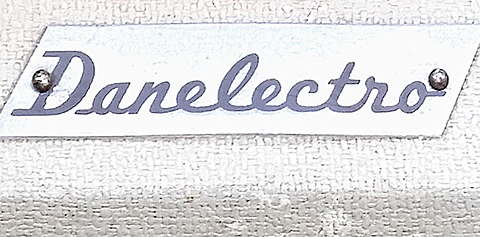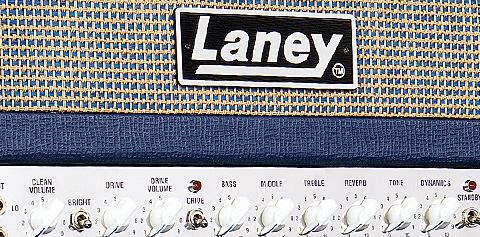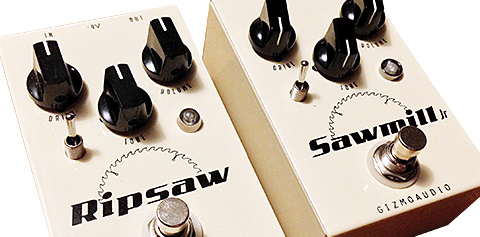
In the august and revered Hall of Fame of Fuzz, the Jordan Boss Tone deserves a prominent pedestal. Perhaps it should be in a cabinet of cute curiosities. Or maybe it’s as a memento mori, an example of a dead end in the search for overdriven guitar tone bliss. Either way, there should be a special spotlight shining down on this little fuzz with the big buzz.
The Boss Tone was a pioneer; this runt of an effect plugged directly into a guitar’s jack; the player then inserted the cord into the bottom of the petite box. The controls (both of them!) were right there, at hand and easy to dial.
And the fuzz could be sublime. The Boss Tone’s tone ranged from a kitten’s purr to a snake’s hiss. Or it could be nasty and trebly. When you found the sweet spot, it had a rich voice in a day when most fuzz boxes prided themselves on being overwhelmingly grainy or downright harsh.
There’s scant information on the maker of this small wonder. Jordan Electronics, of Alhambra, California, was a division of Victoreen Instrument Company, which was founded in 1928 making x-ray dosimeters. During World War II, the firm did top-secret work for the first South Pacific atomic bomb tests, and both Victoreen and Jordan later made civil-defense Geiger counters and radiation detectors for the home, as the Cold War created a market in the ’50s. Their motto was the “World’s First Nuclear Company.”
How Jordan jumped from geiger counters to guitar gear is top secret – or at least unknown – but be thankful they did. Starting circa 1966, the company launched its transistorized Jordan amps, which were known principally for being loud. Endorsed in ads by the Turtles (of “Happy Together” fame) and used at times by the Yardbirds, the Doors, and the Mamas and Papas. Jordan also made a series of more-typical pedal effects including the Creator, Vibrasonic, and the usual volume pedal and wah, christened the Gig Wah.

The Boss Tone Model 1000 was part of the Jordan Junior line, launched circa 1967. Its siblings included the rarer and less-renowned Vico Vibe tremolo/vibrato and the Boss Boost ultra-treble control, both of which were also jack-mounted.
Small is beautiful, as the philosophers preach. And these effects were truly small; the Boss Tone was less than half the size of the ruling Maestro Fuzz Tone or most any other competing fuzz box, then or now.
Still, an early brochure bragged that the Boss Tone was a “complete fuzz effect – sustains any amplified note.” The Volume dial controlled the overall level while the Attack set the instrument input – basically doing the same task as your guitar’s volume knob. And that was it!
Inside was simplicity defined. The circuit used a single transistor as a voltage gate with a second transistor as a buffer. The first version included one PNP and one NPN transistor. That’s all. There was a basic on/off switch, but no true-bypass.
That simplicity was the unit’s brilliance, and one of its limitations. It retailed for just $29.95 – a price matching its size, but also limiting its specs. But the mighty mite screamed, letting loose a prodigious sound that many more-complex units yearned for.
The first Boss Tones from 1967 bear Jordan’s Alhambra address on the back. At some point early on, the company moved to Pasadena, which was duly printed on the units.

Boss Tones stayed in production until the early ’70s, when Jordan dissolved. Legend has it that owner George Cole and engineer Bob Garcia packed up their ohmmeters and went to work for Rickenbacker. But the Boss Tone lived on. Randy California (of Spirit) was the elfin effect’s biggest booster. Playing live, he almost invariably had one of the diminutive fuzz boxes plugged into his guitar, and its sound howls throughout Spirit’s first four albums, creating a glorious blend of freaky pyschedelia and down-and-dirty rock grind. Dan Auerbach, of the Black Keys, still proudly uses his Boss Tone, though it’s modified to do duty as a floor pedal.
Converting the Boss Tone into a stompbox was always common practice. And a wise one: the Boss Tone was not truly built for the rigors of rock and roll. It’s budget wiring is all tiny, 22-gauge, and the soldering doesn’t hold up well. Due to its size, there’s not much shielding inside, and its embarrassing radio-receiving capabilities were equal to its fine buzz.
The Boss Tone’s adoption was limited by its paradigm of plugging straight into the jack; Strat players were left out! Vox tried the same approach with its 1965 Distortion Booster, and Dan Armstrong later offered its Orange Squeezer, Red Ringer, Green Ringer, and other jack-based effects. A sort of Boss Tone replica was built as the Mahoney Buzz Tone. But by and large, the setup was a dead end.
But not for everyone. In Nashville, pedal-steel players became enamored with the Boss Tone, and Shot Jackson and Buddy Emmons’ Sho-Bud firm licensed with Jordan to sell its own version as the Sho-Sound Boss Tone. These were likely built by Jordan and simply badged for Sho-Bud, most dressed in the standard black-plastic housing, though they sometimes turn up as natty red units.

It seems improbable and implausible, but the Boss Tone evolved from a long-haired, psychedelic, hippie fuzz effect to a clean-cut, cowboy-shirted, Nashville pedal-steel player’s fave. Plugged into the side of many an electric table, the Boss Tone is today still venerated and valued.
This article originally appeared in VG March 2014 issue. All copyrights are by the author and Vintage Guitar magazine. Unauthorized replication or use is strictly prohibited.






 KHDK Electronics, the effects company founded by Metallica guitarist Kirk Hammett and industry vet David Karon, has released the No. 1 Overdrive, which uses an original circuit based on a blend of op-amp and mosfet technology. It has two cascading Gain controls to; the first begins with a clean boost while the second shares a knob with the Bass control and acts as an active high-pass filter for the second stage, allowing the user to set the amount of bottom-end response. The pedal is hand-built in Kentucky.
KHDK Electronics, the effects company founded by Metallica guitarist Kirk Hammett and industry vet David Karon, has released the No. 1 Overdrive, which uses an original circuit based on a blend of op-amp and mosfet technology. It has two cascading Gain controls to; the first begins with a clean boost while the second shares a knob with the Bass control and acts as an active high-pass filter for the second stage, allowing the user to set the amount of bottom-end response. The pedal is hand-built in Kentucky. Xotic XSC guitars are hand-built in the U.S. and have a nitrocellulose finish, maple neck, and Raw Vintage hand-wound pickups based on a proprietary design.
Xotic XSC guitars are hand-built in the U.S. and have a nitrocellulose finish, maple neck, and Raw Vintage hand-wound pickups based on a proprietary design. Godin Guitars’ Passion RG-4 Swamp Ash bass has a chambered/contoured body made of cedar with a carved Swamp ash top, maple neck with rosewood or maple fingerboard, Seymour Duncan Quarter-Pound PJ pickups, one Volume and one Tone control with four-way selector, five-ply tortoiseshell pickguard, and high-ratio tuning machines.
Godin Guitars’ Passion RG-4 Swamp Ash bass has a chambered/contoured body made of cedar with a carved Swamp ash top, maple neck with rosewood or maple fingerboard, Seymour Duncan Quarter-Pound PJ pickups, one Volume and one Tone control with four-way selector, five-ply tortoiseshell pickguard, and high-ratio tuning machines.











